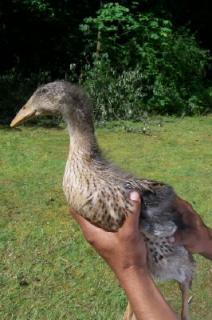Wow! Lots of good questions. I am not sure where to begin. I think you are spot on in your thinking, Lisette. He does look potentially like a light phase dusky. The stock the eggs came from obviously carried dusky genes. Yes, it is something that they should have seen. No offense to anyone breeding rare colors, but the longer you breed these birds, you will see that there are a LOT of breeders (even big name breeders that have been doing this for decades) that don't have even the most basic understanding of the genetics of color. The lack of eye stripes though is a clear indicator that dusky is involved (which it shouldn't be for Trout). What you are describing also sounds like the bird may have carried sex-linked bill color as well that is usually associated with harlequin phase (again, something a Trout should not carry, but it is very easy to confuse for light phase if a person doesn't know what they are looking for).
Why did you think he was Fairy Fawn? I don't breed that color, but I suspect that Fairy Fawn is the old European version of Fawn. If you google "Fawn Runners", you will pull up pictures of birds that are a deep rich caramel color. That is what I suspect some US breeders were calling "Fairy Fawn". As far as the genotype, I can't say for sure. Deciphering all the old literature on color has been a huge undertaking (and for a number of reasons that most of you are aware, I don't post the information on BYC anymore). I am trying these days to reference the older research whenever possible and it seems that the European sources (like Ashton) are more reliable and correct.
Going back to the genotype, I just can't say definitely. What I can say for sure is that what Holderread called "Brown" in Runners, we now call Khaki (dusky mallard with brown dilution). What he calls "Solid Fawn" is what we call Fawn today (dusky mallard with double blue dilution). The UK Fawn does not have the blue dilution. What he called "Cinnamon" is basically just the same series, but with heterozygous Blue. What he called "Blue Fawn" is really "Blue Fairy Fawn" and what he called "Blue Pearl" is really what we now call "Blue Fawn". Are you confused yet? Fairy Fawn is obviously dusky based, but I wouldn't think it would just be with brown dilution because that would be Khaki (aka the incorrectly called "Brown"). Most of the evidence I have found though does seem to indicate it is basically Khaki. I am not sure why though Holderread also mentioned Brown if it was the same genotype as Fairy Fawn (and Khaki). It could perhaps be Khaki that has been selectively bred for more gold tones or there could be some modifying genes presents (or it could be an entirely different genotype). I do remember reading one reference in the Ashton Runner book about Fawn being bred back to Grey (Mallard) at one point and a richer color resulting.
Who knows. With some of these obscure colors, it is very possible that even the people breeding them do not know. The longer I focus on really learning the genetic aspect, the more common it seems that is. The more you read, the more you will begin to decipher the colors and who really knows what. After awhile, it will become more clear how the colors are "built" and interrelated. You will see that some things written in the past simply do not make sense or are flat out incorrect. That is understandable though. Different authors have natural aptitudes for different things. We are quite spoiled these days as well because all of the information is at our fingertips and when some of the earlier authors/researchers were doing their work, it was much more difficult to find information and be able to cross reference it. The point is that I think you should research all sources of information and then if you want to work with a color, test that information yourself via test crosses. You will find, like I have, that a lot of the information in print is not correct (or current). IMHO, the *most* correct and current source of information is the Ashtons. They have done a lot of the legwork for us by drawing on the research of other earlier authors and actually testing it.





